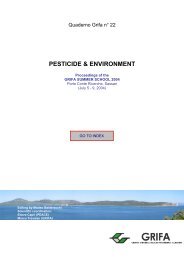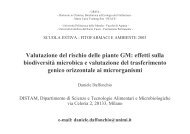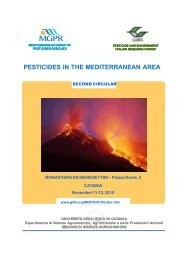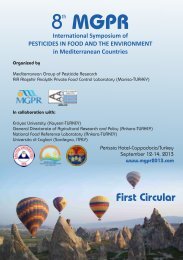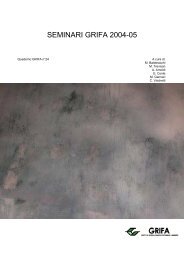International Congress BIOLOGICAL PRODUCTS - Gruppo di ...
International Congress BIOLOGICAL PRODUCTS - Gruppo di ...
International Congress BIOLOGICAL PRODUCTS - Gruppo di ...
Create successful ePaper yourself
Turn your PDF publications into a flip-book with our unique Google optimized e-Paper software.
12<br />
DETERMINATION OF Cd (II), Cu (II), Pb (II), AND Zn (II) IN <strong>BIOLOGICAL</strong> AND NOT <strong>BIOLOGICAL</strong><br />
CITRUS ESSENTIAL OILS BY DERIVATIVE POTENTIOMETRIC STRIPPING ANALYSIS (dPSA)<br />
Dugo Giacomo, Giuffrida Daniele, Drogo Alessandra, La Pera Lara<br />
Dipartimento <strong>di</strong> Chmica Organica e Biologica Università <strong>di</strong> Messina Salita Sperone, 31, 90166 S. Agata -Messina<br />
Citrus essential oils are complex mixtures of many classes of volatile (85-98%) and not volatile (15-2%)<br />
compounds (1); they are used in food and cosmetic farm as aromatizer and in pharmaceutical industry as ad<strong>di</strong>tives of<br />
some drugs (2). Their wide use implies a strict control of the presence of organic and inorganic contaminants as heavy<br />
metals. There is a lack of available data regar<strong>di</strong>ng to the presence of heavy metals: some reports concerning to the<br />
micro-elements composition of citrus peel extracts were found (3,4). Metals levels in citrus essential oils mostly<br />
depend on the type of soil, agrochemical treatments, but also on extraction procedures as scraping or pressing, since<br />
the fruits inevitably come in contact with metallic surfaces (5). In this work potentiometric stripping analysis is used to<br />
determine the content of Cd (II), Cu (II), Pb (II) and Zn (II) in lemon, mandarin, orange and bergamot non biological<br />
essential oils produced in Sicily and Calabria in the crop year 1999 (6). Moreover 13 samples of bergamot biological<br />
essential oils and 13 samples of non-biological essential oils produced in Calabria in the crop year 2000, were stu<strong>di</strong>ed.<br />
MATERIALS AND METHODS<br />
Reagents<br />
All oils are sampled in dark glassy bottles, with blind nipples, and stored at 4°C until the analyses. Ultra pure<br />
hydrochloric acid (34-37%), Hg (II) (1000 µgmL -1 , 1M in hydrochloric acid) and Cd (II), Cu (II), Pd (II), Pb (II), Zn (II)<br />
(1000 µgmL -1 , 0.5 N in HNO3) standard solutions were purchased by Panreac (Barcelona, Spain); Ga (NO3)3⋅3H2O (5 g,<br />
99.9%) was purchased by Aldrich Chem. Co. (Milwakee, WI, USA). The extracts were filtrated on a carbon column<br />
Supelclean ENVI-Carb SPE (0.5 g, 6 mL), purchased by Supelco (Bellefonte, PA, USA).<br />
Apparatus<br />
Metals analysis are carried out by a PSA ION 3 potentiometric stripping analyzer (Steroglass, S. Martino in Campo,<br />
Perugia, Italy), connected to an IBM-compatible personal computer. The analyzer operates under the control of the<br />
NEOTES 2.0.1 software package (Steroglass). The determination is carried out in a conventional three-electrode cell.<br />
The working electrode was a glassy carbon one coated with a thin mercury film; reference electrode was an Ag/AgCl<br />
electrode (KCl 3M), and a platinum wire auxiliary electrode was used.<br />
Procedures<br />
Hydrochloric acid extraction<br />
A 8.60 g (10.00 mL) sample aliquot and a 10 mL volume of 36% ultrapure-hydrochloric acid (Panreac, Barcellona), are<br />
introduced in a teflon beaker. The extraction was carried out for about 30 min under magnetic stirring at the temperature<br />
of 90 °C. The acid sample, was transferred in a separating funnel and let to cool for about 5 minutes. In order to favour<br />
the separation of the two phases, the mixture is spiked with 1.0 mL ultrapure methanol, then the acid layer was collected<br />
in a 20.00 mL flask. The organic layer is extracted again with 4.50 mL of concentrated hydrochloric acid for 5 min,<br />
under the same con<strong>di</strong>tions described, and then washed with 4.50 mL of boiling water; washings were added to the acid<br />
extracts and made up to the mark with water. The obtained solution was passed through a carbon column. The filtered<br />
solution was used for the simultaneous determination of Cd (II), Cu (II), Pb (II), and Zn (II).<br />
Potentiometric determination<br />
All analysis were executed in a conventional three electrodes cell; working electrode was a glassy carbon electrode<br />
coated with a Hg film, the reference one was an Ag/AgCl electrode, the counter was a Pt electrode. The concentrations<br />
of Cd (II), Cu (II), Pb (II), and Zn (II) were simultaneously determined. 1.00 mL of acid extract, 17.50 mL of ultrapure<br />
water, 1.00 mL of 1000 µg mL -1 Hg (II) as oxidant agent and 0.50 mL of 10 µg mL -1 Ga (III) - in order to prevent<br />
Cu-Zn complexes formation on the mercury film (6)- were put into the electrochemical cell. The quantitative analysis<br />
was executed by the multiple points standard ad<strong>di</strong>tions method. The potentiometric parameters are reported on table 1.<br />
Method performances<br />
PDF creato con FinePrint pdfFactory versione <strong>di</strong>mostrativa http://www.secom.re.it/fineprint<br />
76



